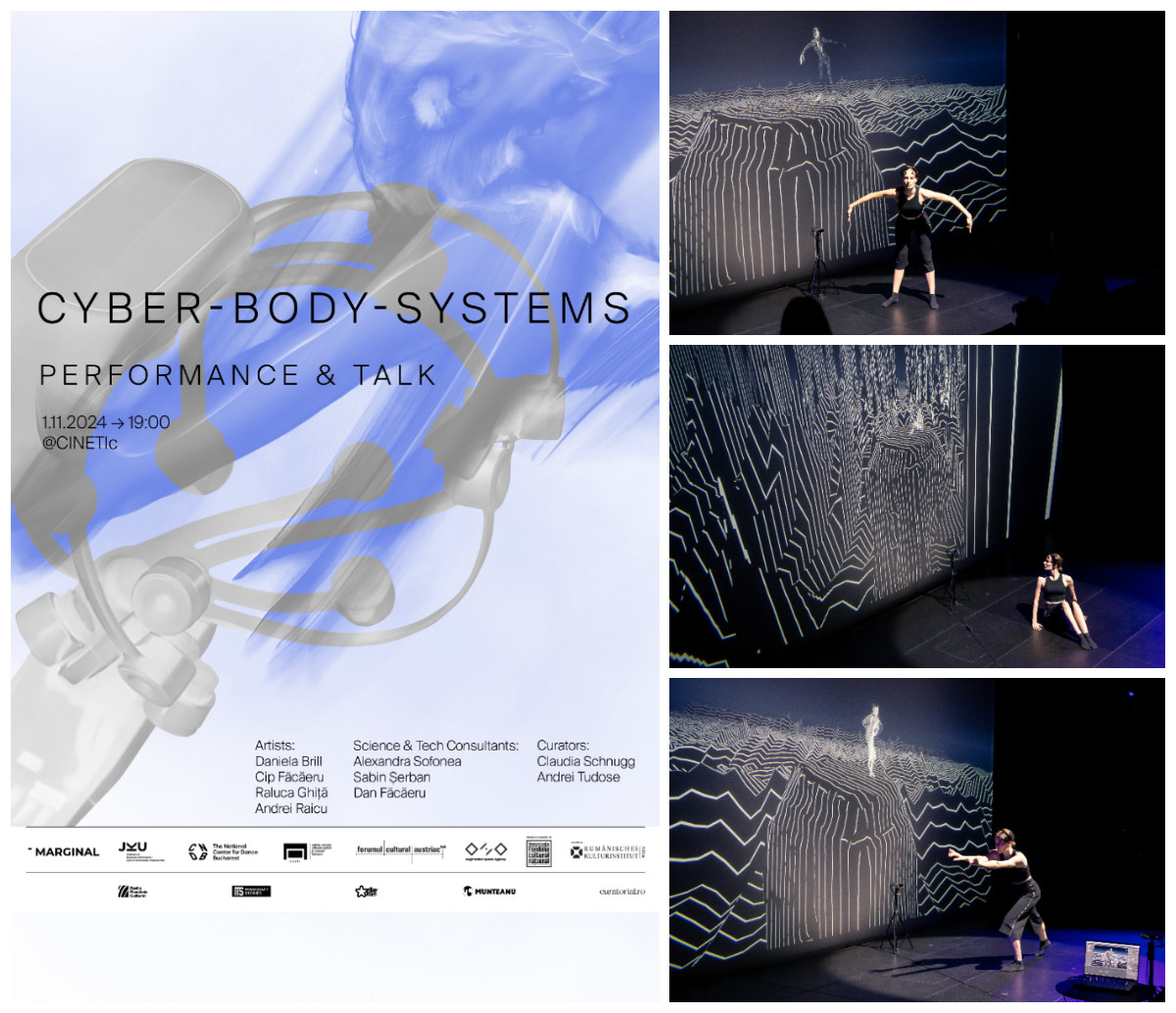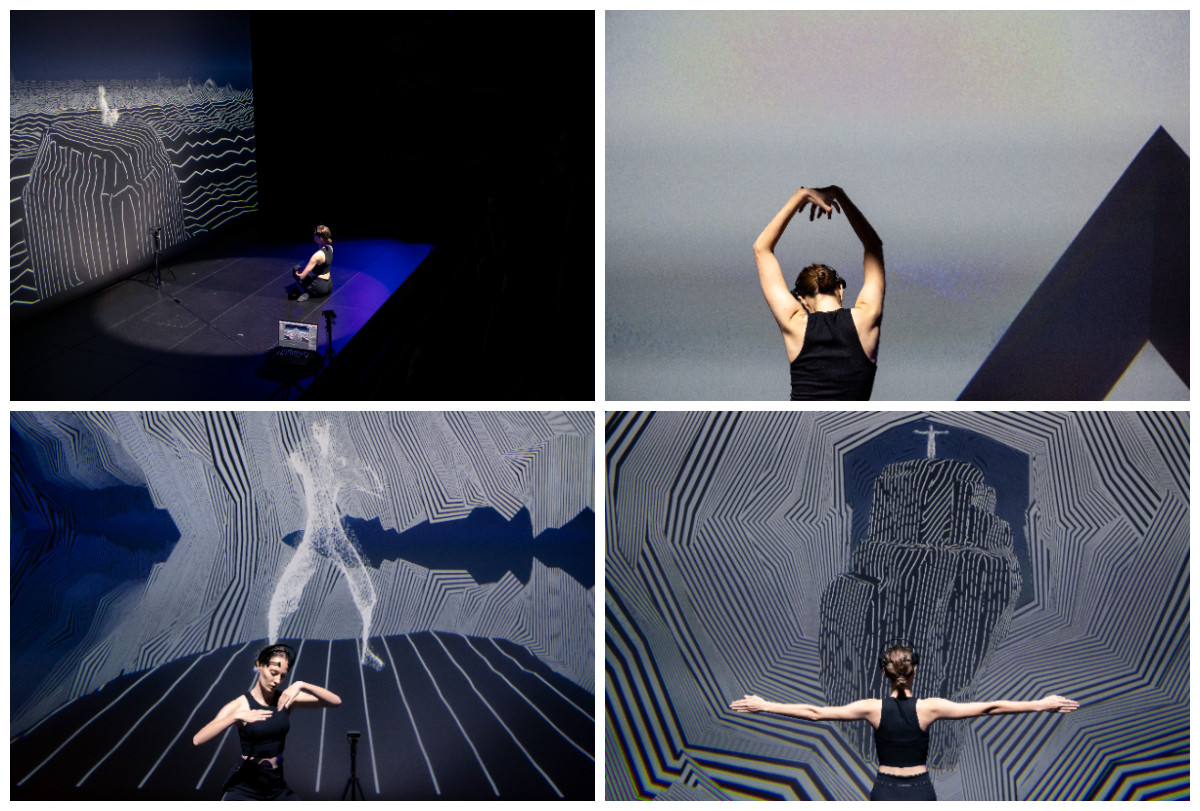The physical body, the digitized body and the “invisible” body. Negotiating between these poses through dance. Awareness of power relationship and limits of control. In an immersive performance, made by Raluca Ghitaits movements, thoughts and electrical impulses are captured and transformed in real time, creating a feedback loop between the physical and virtual bodies.
On November 1, from 7:00 p.m., at CINETic and on November 5, from 7:30 p.m., during the Iridescent Festival, at National Dance Center, the audience in Bucharest can witness a unique show that challenges the imagination and invites the audience to experience the fascinating boundaries between the physical and the digital body. Cyber-Body-Systems is part of the Marginal association’s project of the same name, and combines scientific research and artistic production to investigate how technology influences and redefines human reality, and explores how digitization affects our perceptions and reactions to internal and external environments. external.
Using EEG and motion capture sensors, the performance transposes the dancer into a dynamic and unpredictable digital landscape. In the framework of a discussion applied after the performance, the conclusions of an extensive research, carried out through a bilateral artistic residency program, will be presented.
Raluca Andreea Ghiță is a graduate of UNATC (Choreography) and a student at UNEFS (Kinetotherapy and special motor skills). In his research, he explores the movement of the body and the impact of technology on it. A model since 2015, Raluca is fascinated by how technology takes inspiration from the natural processes of the human body and integrates movement into artistic creation and physical therapy.
In the following lines, Raluca tells about the course and development of the performance within the Cyber-Body-Systems project, carried out during this year.
Your artistic journey
The passion for choreography started in childhood when all I did was organize shows in the living room for my family. I have always had an uplifting feeling when I danced and created movements to a musical background. Choreography was my passion and refuge before I knew techniques and concepts.
The interest in the use of technology in the evaluation and quantification of the physical aspects of the body began with the perspective of physical therapy, which I approached as a continuation of those acquired in the field of choreography. I was reading many studies about movement and dance therapy carried out in different pathologies, carried out with the help of the EEG device before and after the movement process, but I was more interested in observing the neurophysiological changes and the benefits of dance during the movement process, which I was able to explore in this project.
Proiectul Cyber-Bodies-System
The project was recommended to me by some friends who knew that I was interested in both the artistic side of the human body and its “unseen”, scientific side. Thus, I went to the casting and was very surprised and happy when I found out that I was selected, since there were many people with potential in these directions that the project proposes.
The choreographic process was a slow one, compared to the others, the technological part and the neuroscience part, which took shape very clearly from the beginning. Together with them, I first understood the limitations imposed on choreography: space, noise, projection, delays. The space was delimited by three motion capture sensors in the shape of an equilateral triangle with a side of 4 m. Another thing was the EEG helmet which, during sudden movements and especially those of changing body weight, recorded more noises from rubbing the sensors with the scalp and hair, rather than cranial activity.
The projection on a single screen, used to landscape the cranial waves, focused my attention in a single plane, and the larger or smaller delays that occurred following some movements tested my tolerance for frustration. After understanding the limits, I realized that I cannot do a choreography with predetermined movements in a context that is different every time. My cranial waves were different, so the landscape and the music, influenced by my cranial activity, would be different every time. I began to focus more on my body in that context than on its aesthetics. The directions I gave myself were more focused on the unseen part of the body in motion: heartbeat, breathing, increased blood pressure, movement of ears, lips, tongue, intra-abdominal organs.
All these were tools for me to explore the impact I had or not on the landscape and the sound. I set out to see to what extent I could control these aspects. Also, my focus was more on the needs of the body. When I feel the need to blink or yawn, how long I can hold my breath and when my body demands these things. Certain ideas taken from scientific studies helped me a lot in understanding the neural mechanisms that lead to one degree or another to controlling the limits I was responsible for in that set up.
The first was the idea of ”resting states” and ways in which I can relax with my eyes closed and open, watching my breath and letting my mind wander. Other things that helped me better understand the process I was in and how I could control it were “motor imagery”, “mirroring”, “matching”, proprioception and physiological ways by which I could control my “unseen” body (eg: using carotid pressure points to lower blood pressure). Experiencing a different context each time during the performance, my approaches were different. We were reusing some things that we knew from previous experiments that worked (blinking and sudden body movements made a lot of sensor friction noise on some lobes of the brain, for example: blinking acted on sensors in the frontal lobe). In addition to the mechanisms that I knew worked, I was always looking for something new, other possibilities to use my body to control what I saw in the projection and the sound.
The choreographic process was and is closely related to the technological process. All the sensors, either around me or attached to my body, became to some extent like an expanded body, extended in all space. The first sensation was bizarre, as if I had been turned upside down and my whole “unseen” body was visible, at which point the audience became a witness more involved in my perceptions. The development of the process, both choreographically and technologically, brought the performance to the point where it is not just a visualization of my body, but a total immersion of the “seen” body in the “unseen” one.
Interaction with technology
By technology I think we often mean mechanisms, routine, stable organization, but through this project I felt that none of these have their place. Personally, interacting with technology means a dynamic balance, ever-changing, adaptability. We often tend to use what we know works and rarely seek to discover something new. As an artist it is easy to have predetermined themes, a clear path. It is the optimal context in which I feel in control.
By working so closely with technology, I’ve realized how many things I’m not actually in control of and how I can adapt to this constant frustration when what I do doesn’t have the result I expect or what I know works isn’t up to everyone valid date. In the context in which I performed, I had several bodies: the physical body, the digitized body and the “unseen” body. Many times it was a challenge to understand and control them all, to combine them or to simply accept that there were times when one of them was more “vocal” or had more to say.
The relationship between physical and digital, body, mind and technology
The difference between the physical and the digital body lies in perception. My body is in front of a digital mirror, but the brain is fooled by the fact that the “other me” reacts late or not at all. Such a relationship brings us face to face with a more complex decision-making process. Do I choose to drive, sync, or walk independently of the digital body? Such a process does not make understanding easier, but creates more questions, and art in this context provides many more answers and possibilities to search for answers in the process of understanding.
Your performance
Performance is a reflection of the fact that we are not and have no way of being in control in all aspects simultaneously. We have limitations, but which can help us adapt more effectively, perhaps to reach other limitations and so on. I think that the purpose of these perspectives that we present through this project is not to show that we can find tools through which to control, but experiences through which we can understand the context and adapt effectively to the tasks we aim to solve. It’s a choice between adapting or giving up.
Imagination exercise: what would such a performance look like 100 years from now
Being an interdependent relationship between performance and the technology used, I am firmly convinced that with the evolution of technology, including performance, will take on a different form. I assume that the interaction between the physical body and the digital one will be much developed, to the extent that the digital body would not only take over the corporeality and characteristics of the physical one, but would perhaps reach the level of initiating movement contexts that the physical body does not -he also acquired a digital body that in 100 years would develop its own kinesthetic memory and contribute to the recovery through art, for example, of those with neurological pathologies, who begin to lose these motor sensations.
Cyber-Body-Systems is a project of Marginal, a non-profit cultural organization from Romania, which aims to support, promote and expand bridges between artists and various agents from other fields, with an emphasis on the humanities, respectively the implications of science and technology in socio-cultural structures .
The project is coordinated by Claudia Schnugg (Austria, initiator of DIGI-Sense within the Institute of Business Informatics – Communications Engineering of the Johannes Kepler University in Linz) and Andrei Tudose (Romania, artistic director). Cyber-Body-Systems is the result of the collaboration between the Austrian artist Daniela Brill and Romanian artists Raluca Ghita, Cip Făcăeru, Andrei Raicuthe neuroscientist Alexandra Sofoniaand the technical team consisting of Sabin Şerban and Dan Făcăeru. The project started in June with an open research session with the public in Romania, followed by the residency in Austria and a performative work in progress installation in Linz.
Source: www.iqads.ro




